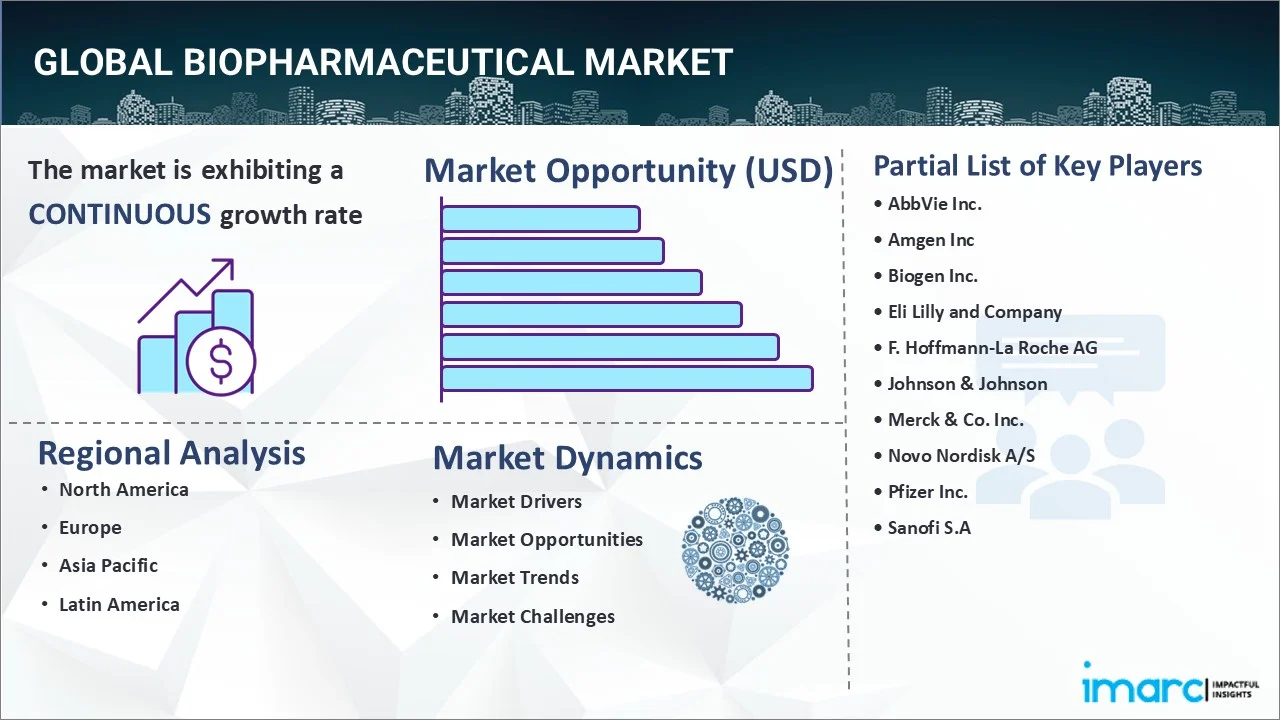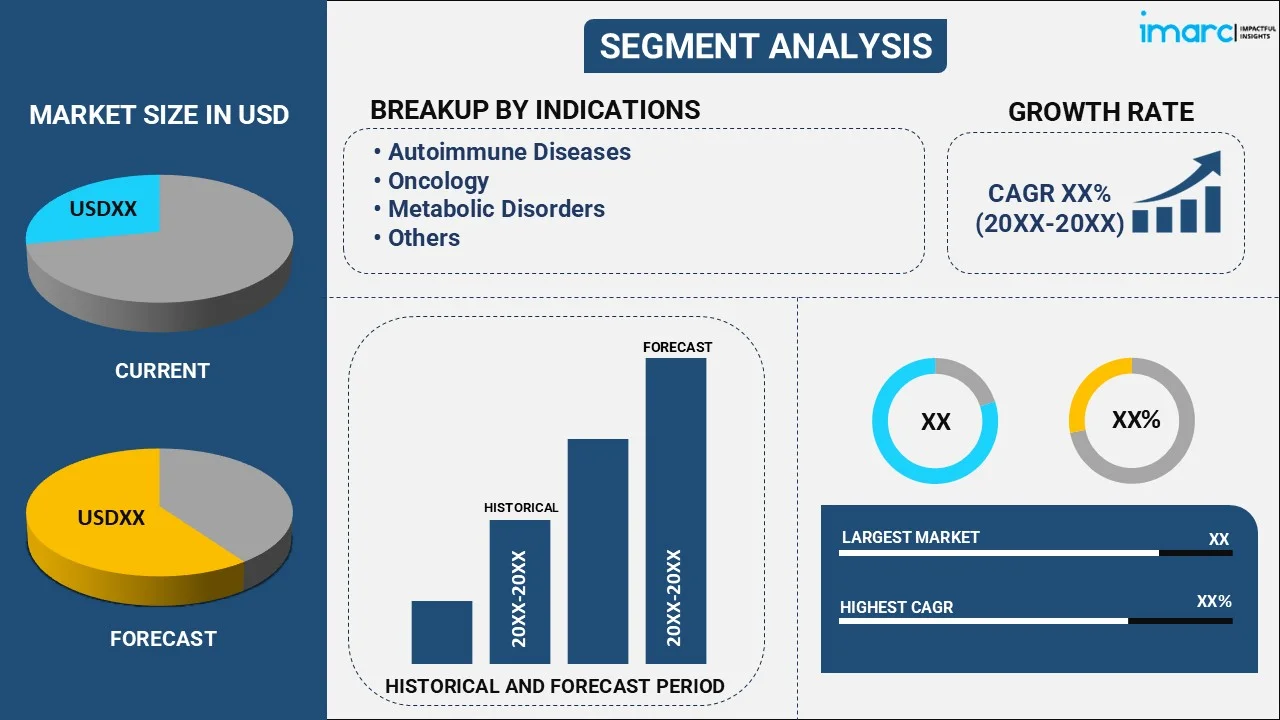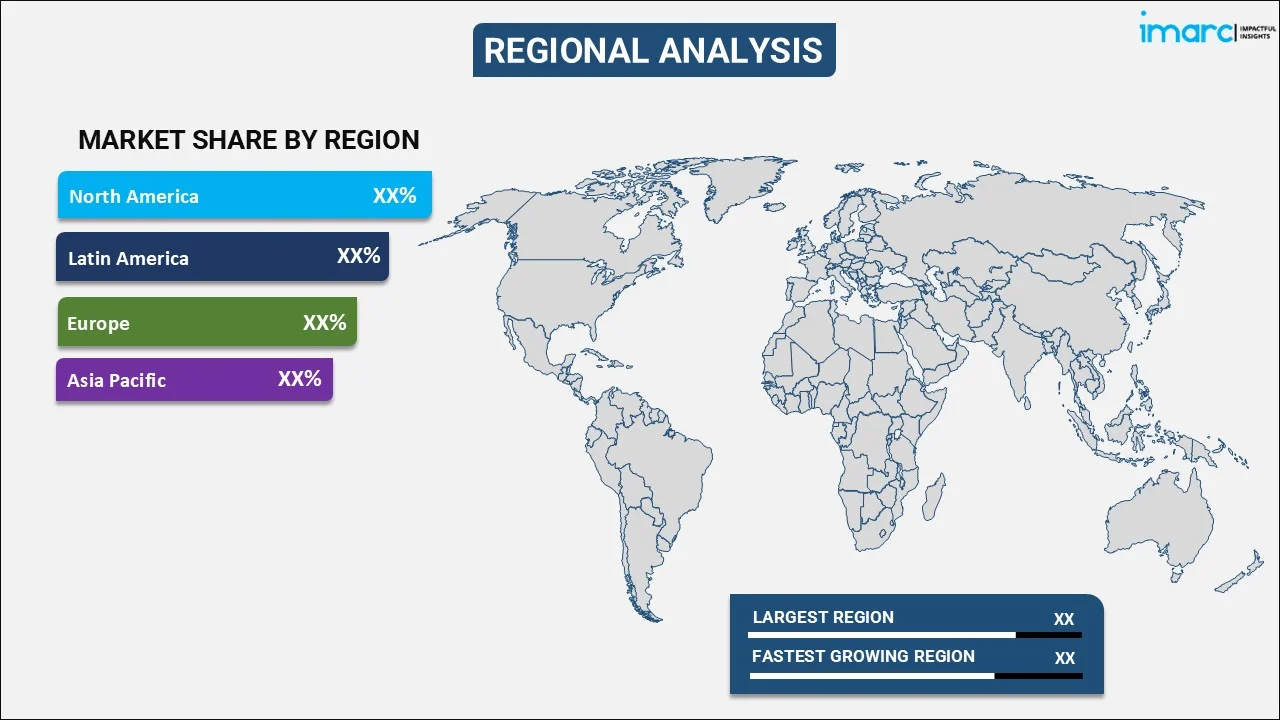
Biopharmaceutical Market Report by Indication (Autoimmune Diseases, Oncology, Metabolic Disorders, and Others), Class (Recombinant Proteins, Monoclonal Antibodies, Purified Proteins), and Region 2025-2033
Biopharmaceutical Market Size:
The global biopharmaceutical market size reached USD 326.2 Billion in 2024. Looking forward, IMARC Group expects the market to reach USD 664.8 Billion by 2033, exhibiting a growth rate (CAGR) of 8.2% during 2025-2033. The market has been propelled by the increasing prevalence of chronic illnesses, significant advancements in biopharmaceutical, rising government support and healthcare expenditure, personalized medicine and targeted therapies, expansion of biosimilars, and increasing utilization of artificial intelligence and machine learning.
|
Report Attribute
|
Key Statistics
|
|---|---|
|
Base Year
|
2024
|
|
Forecast Years
|
2025-2033 |
|
Historical Years
|
2019-2024
|
| Market Size in 2024 | USD 326.2 Billion |
| Market Forecast in 2033 | USD 664.8 Billion |
| Market Growth Rate 2025-2033 | 8.2% |
Biopharmaceutical Market Analysis:
- Major Market Drivers: Some of the major market drivers include the rising number of individuals diagnosed with chronic illnesses, significant developments in biopharmaceutical, and increasing government support and healthcare expenditure.
- Key Market Trends: Increasing emphasis on developing drugs, rising adoption of biosimilar products, and use of artificial intelligence (AI) and machine learning (ML) are some of the major key market trends responsible for the biopharmaceutical market growth drivers.
- Geographical Trends: Robust research and development infrastructure, healthcare policy and regulatory support, and high healthcare expenditure is propelling the North America biopharmaceutical market.
- Competitive Landscape: Some of the major market players in the biopharmaceutical industry include AbbVie Inc., Amgen Inc., Biogen Inc., Eli Lilly and Company, F. Hoffmann-La Roche AG, Johnson & Johnson, Merck & Co. Inc., Novo Nordisk A/S, Pfizer Inc., Sanofi S.A., among many others.
- Challenges and Opportunities: Some of the challenges include high costs of drug development, strict regulatory requirements, and intellectual property issues. Whereas, growth in emerging markets, advanced drug delivery systems, and significant number of collaborations and partnerships are some of the opportunities of the industry.

Biopharmaceutical Market Trends:
Increased Prevalence of Chronic Diseases
The global rise in chronic diseases such as cancer, diabetes, cardiovascular diseases, and autoimmune disorders is a significant driver of the biopharmaceutical market. Chronic diseases require prolonged treatment and often rely on biopharmaceuticals for management and therapy, driving demand for these products. For instance, cancer has become a critical area for biopharmaceuticals with the development of targeted therapies that provide more effective and personalized treatment options compared to traditional chemotherapeutics. According to the World Health Organization, cancer is the second leading cause of death globally, accounting for an estimated 9.6 million deaths in 2018. The increasing cancer incidence globally necessitates ongoing development and commercialization of biopharmaceuticals, such as monoclonal antibodies and cancer vaccines, which are often more effective and have fewer side effects than conventional treatments. This demand leads to substantial investments in R&D by major pharmaceutical companies and a rise in public and private funding aimed at combating these chronic conditions.
Significant Advancements in Biopharmaceutical
Biopharmaceutical advancements are pivotal in the evolution and growth of the biopharmaceutical market. These advancements include genetic engineering, high-throughput screening technologies, and next-generation sequencing, among others. These technologies enhance the ability of researchers to understand diseases at a molecular level and to develop drugs that can target these diseases more effectively and safely, further shaping a positive biopharmaceutical market dynamics. According to the IMARC GROUP, the global genomics market, has reached USD 33.9 Billion in 2023, and is expected to reach USD 107.5 Billion by 2032, exhibiting a CAGR of 13.3% during 2024-2032. This growth is indicative of the critical role genomics plays in drug discovery and personalized medicine, both of which are essential to the development of biopharmaceuticals. Improved biotechnological tools speed up the drug discovery process and also increase the success rate of the drugs developed, thereby attracting more investments and research into this sector.
Rising Government Support and Healthcare Expenditure
Government initiatives and healthcare spending are crucial in propelling the biopharmaceutical market forward. Many governments worldwide are increasing their healthcare budgets, which includes funding for the research and development of biopharmaceuticals. This is particularly evident in developed countries, where there is a strategic focus on sustaining innovation to maintain a competitive edge in the global healthcare market. For instance, India spends almost $ 1.4 billion on biomedical research, according to the HINDUSTAN TIMES. This substantial investment in health research reflects the support of the government for the biopharmaceutical industry, providing the necessary financial resources to fuel research, development, and the adoption of advanced therapies. Such government backing enhances the development capabilities of biopharmaceutical firms and helps in the faster commercialization of new drugs, ensuring that these innovations reach the market and become accessible to patients in need, thus creating a positive biopharmaceutical market outlook.
Biopharmaceutical Market Segmentation:
IMARC Group provides an analysis of the key trends in each segment of the market, along with forecasts at the global, regional, and country levels for 2025-2033. Our report has categorized the market based on indication and class.
Breakup by Indication:

- Autoimmune Diseases
- Oncology
- Metabolic Disorders
- Others
Autoimmune accounts for the majority of the market share
The biopharmaceutical market research report has provided a detailed breakup and analysis of the market based on the indication. This includes autoimmune diseases, oncology, metabolic disorders, and others. According to the report, autoimmune diseases represented the largest segment.
Autoimmune diseases represent the largest segment in market breakup by indication within the biopharmaceutical sector primarily due to the high prevalence and chronic nature of these conditions, coupled with a significant unmet need for effective and sustainable treatments. Autoimmune diseases, which include conditions such as rheumatoid arthritis, multiple sclerosis, and lupus, affect millions globally, necessitating long-term, often lifelong management. The complexity of these diseases, characterized by the immune system mistakenly attacking the tissues of their own body, demands therapies that are highly specific and capable of modulating immune responses without severe side effects. Biopharmaceuticals, particularly biologics such as monoclonal antibodies and fusion proteins, have been revolutionary in this field. They offer targeted therapies that specifically address underlying immune dysfunctions, leading to better disease management and improved quality of life for patients.
Breakup by Class:
- Recombinant Proteins
- Monoclonal Antibodies
- Purified Proteins
Monoclonal antibodies hold the largest share of the industry
A detailed breakup and analysis of the market based on the class have also been provided in the report. This includes recombinant proteins, monoclonal antibodies, and purified proteins. According to the report, monoclonal accounted for the largest biopharmaceutical market share.
Monoclonal antibodies dominate the biopharmaceutical market as the largest segment in market breakdown by class due to their highly targeted therapeutic capabilities and broad applicability across various diseases. These antibodies are engineered to bind to specific antigens present on the surface of cells or pathogens, allowing for precise targeting of diseases such as cancer, autoimmune disorders, and infectious diseases. Their ability to be tailored for specific targets enhances their efficacy and minimizes off-target effects, which contributes to their substantial market share. The growing prevalence of chronic diseases and the increasing demand for personalized medicine have further amplified the reliance on monoclonal antibodies, thereby creating a positive biopharmaceutical industry overview.
Breakup by Region:

- North America
- United States
- Canada
- Latin America
- Mexico
- Brazil
- Argentina
- Europe
- Germany
- France
- Italy
- Spain
- United Kingdom
- Russia
- Turkey
- Asia Pacific
- Japan
- China
- Australia
- South Korea
- India
- Indonesia
North America leads the market, accounting for the largest biopharmaceutical market share
The report has also provided a comprehensive analysis of all the major regional markets, which include North America (the United States and Canada); Latin America (Mexico, Brazil, and Argentina); Europe (Germany, France, Italy, Spain, the United Kingdom, Russia, and Turkey); and Asia Pacific (Japan, China, Australia, South Korea, India, and Indonesia). According to the report, North America was the largest regional market for biopharmaceuticals.
North America is the largest segment in the global biopharmaceutical market primarily due to its well-established healthcare infrastructure, significant research and development investments, and a robust regulatory framework. The United States, in particular, is home to numerous leading biopharmaceutical companies and research institutions that drive innovation in drug development and biopharmaceutical. The region benefits from substantial public and private funding, which supports extensive R&D activities and the commercialization of advanced therapeutics. Additionally, the high healthcare spending and advanced medical infrastructure of North America ensure that new biopharmaceutical products are rapidly adopted and integrated into clinical practice.
Competitive Landscape:
- The market research report has also provided a comprehensive analysis of the competitive landscape in the market. Detailed profiles of all major companies have also been provided. Some of the major market players in the biopharmaceutical industry include AbbVie Inc., Amgen Inc., Biogen Inc., Eli Lilly and Company, F. Hoffmann-La Roche AG, Johnson & Johnson, Merck & Co. Inc., Novo Nordisk A/S, Pfizer Inc., Sanofi S.A.
(Please note that this is only a partial list of the key players, and the complete list is provided in the report.)
- Major biopharmaceutical companies are driving growth through a variety of strategic efforts, including substantial investments in research and development (R&D), strategic partnerships, and technological advancements. Major biopharmaceutical companies such as Pfizer, Roche, and Novartis are dedicating significant resources to developing innovative therapies and expanding their product portfolios. They are also forming strategic alliances with biopharmaceutical firms, research institutions, and technology companies to accelerate drug discovery and development processes. For instance, partnerships with technology firms are enhancing capabilities in artificial intelligence and data analytics, which streamline drug discovery and improve precision medicine. According to the biopharmaceutical market forecast, these companies are also investing in cutting-edge technologies such as gene and cell therapies to address unmet medical needs and tap into emerging markets.
Biopharmaceutical Market News:
- 26 July, 2024: BeiGene, an oncology company, announced that it has opened a new biologics manufacturing facility at the Princeton West Innovation Campus in Hopewell, NJ. The facility represents the company’s flagship facility in the United States and also houses a clinical R&D center. The company invested $800 million into the site to expand its integrated manufacturing and R&D footprint in the US.
- 4 January, 2024: ABBVIE and UMOJA BIOPHARMA have entered into exclusive agreements to develop in-situ generated CAR-T cell therapy candidates for oncology using the VivoVecTM platform of Umoja.
Biopharmaceutical Market Report Scope:
| Report Features | Details |
|---|---|
| Base Year of the Analysis | 2024 |
| Historical Period | 2019-2024 |
| Forecast Period | 2025-2033 |
| Units | Billion USD |
| Scope of the Report | Exploration of Historical Trends and Market Outlook, Industry Catalysts and Challenges, Segment-Wise Historical and Future Market Assessment:
|
| Indications Covered | Autoimmune Diseases, Oncology, Metabolic Disorders, Others |
| Classes Covered | Recombinant Proteins, Monoclonal Antibodies, Purified Proteins |
| Regions Covered | North America, Latin America, Europe, Asia Pacific |
| Countries Covered | United States, Canada, Mexico, Brazil, Argentina, Germany, France, Italy, Spain, United Kingdom, Russia, Turkey, Japan, China, Australia, South Korea, India, Indonesia |
| Companies Covered | AbbVie Inc., Amgen Inc, Biogen Inc., Eli Lilly and Company, F. Hoffmann-La Roche AG, Johnson & Johnson, Merck & Co. Inc., Novo Nordisk A/S, Pfizer Inc., Sanofi S.A etc. |
| Customization Scope | 10% Free Customization |
| Post-Sale Analyst Support | 10-12 Weeks |
| Delivery Format | PDF and Excel through Email (We can also provide the editable version of the report in PPT/Word format on special request) |
Key Benefits for Stakeholders:
- IMARC’s industry report offers a comprehensive quantitative analysis of various market segments, historical and current market trends, market forecasts, and dynamics of the biopharmaceutical market from 2019-2033.
- The research report provides the latest information on the market drivers, challenges, and opportunities in the global biopharmaceutical market.
- The study maps the leading, as well as the fastest-growing, regional markets. It further enables stakeholders to identify the key country-level markets within each region.
- Porter's five forces analysis assists stakeholders in assessing the impact of new entrants, competitive rivalry, supplier power, buyer power, and the threat of substitution. It helps stakeholders to analyze the level of competition within the biopharmaceutical industry and its attractiveness.
- The competitive landscape allows stakeholders to understand their competitive environment and provides insight into the current positions of key players in the market.
Key Questions Answered in This Report
The global biopharmaceutical market was valued at USD 326.2 Billion in 2024.
We expect the global biopharmaceutical market to exhibit a CAGR of 8.2% during 2025-2033.
The rising prevalence of chronic diseases, along with the increasing demand for biopharmaceuticals to provide targeted treatment with fewer side effects, is primarily driving the global biopharmaceutical market.
The sudden outbreak of the COVID-19 pandemic has led to the growing adoption of biopharmaceuticals for developing novel vaccines to reduce the risk of the coronavirus infection.
Based on the indication, the global biopharmaceutical market has been segmented into autoimmune diseases, oncology, metabolic disorders, and others. Among these, autoimmune diseases currently exhibit clear dominance in the market.
Based on the class, the global biopharmaceutical market can be bifurcated into recombinant proteins, monoclonal antibodies, and purified proteins. Currently, monoclonal antibodies account for the majority of the total market share.
On a regional level, the market has been classified into North America, Latin America, Europe, and Asia Pacific, where North America currently dominates the global market.
Some of the major players in the global biopharmaceutical market include AbbVie Inc., Amgen Inc, Biogen Inc., Eli Lilly and Company, F. Hoffmann-La Roche AG, Johnson & Johnson, Merck & Co. Inc., Novo Nordisk A/S, Pfizer Inc., and Sanofi S.A.
Need more help?
- Speak to our experienced analysts for insights on the current market scenarios.
- Include additional segments and countries to customize the report as per your requirement.
- Gain an unparalleled competitive advantage in your domain by understanding how to utilize the report and positively impacting your operations and revenue.
- For further assistance, please connect with our analysts.
 Inquire Before Buying
Inquire Before Buying
 Speak to an Analyst
Speak to an Analyst
 Request Brochure
Request Brochure
 Request Customization
Request Customization




.webp)




.webp)












